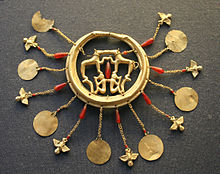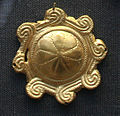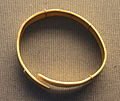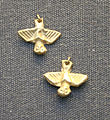
Jewellery consists of decorative items worn for personal adornment such as brooches, rings, necklaces, earrings, pendants, bracelets, and cufflinks. Jewellery may be attached to the body or the clothes. From a western perspective, the term is restricted to durable ornaments, excluding flowers for example. For many centuries metal such as gold often combined with gemstones, has been the normal material for jewellery, but other materials such as glass, shells and other plant materials may be used.

Carnelian is a brownish-red mineral commonly used as a semiprecious stone. Similar to carnelian is sard, which is generally harder and darker; the difference is not rigidly defined, and the two names are often used interchangeably. Both carnelian and sard are varieties of the silica mineral chalcedony colored by impurities of iron oxide. The color can vary greatly, ranging from pale orange to an intense almost-black coloration. Significant localities include Yanacodo (Peru); Ratnapura ; and Thailand. It has been found in Indonesia, Brazil, India, Russia (Siberia), and Germany. In the United States, the official State Gem of Maryland is also a variety of carnelian called Patuxent River stone.

Lapis lazuli, or lapis for short, is a deep-blue metamorphic rock used as a semi-precious stone that has been prized since antiquity for its intense color. Originating from the Persian word for the gem, lāžward, lapis lazuli is a rock composed primarily of the minerals lazurite, pyrite and calcite. As early as the 7th millennium BC, lapis lazuli was mined in the Sar-i Sang mines, in Shortugai, and in other mines in Badakhshan province in modern northeast Afghanistan. Lapis lazuli artifacts, dated to 7570 BC, have been found at Bhirrana, which is the oldest site of Indus Valley civilisation. Lapis was highly valued by the Indus Valley Civilisation. Lapis beads have been found at Neolithic burials in Mehrgarh, the Caucasus, and as far away as Mauritania. It was used in the funeral mask of Tutankhamun.

A necklace is an article of jewellery that is worn around the neck. Necklaces may have been one of the earliest types of adornment worn by humans. They often serve ceremonial, religious, magical, or funerary purposes and are also used as symbols of wealth and status, given that they are commonly made of precious metals and stones.

Puabi. The meaning of the name Puabi is uncertain but it could perhaps mean "word of my father" or "orchard of my father." This person, also called Shubad or Shudi-Ad due to a misinterpretation by Sir Charles Leonard Woolley, was an important woman in the Sumerian city of Ur, during the First Dynasty of Ur. Commonly labeled as a "queen", her status is somewhat in dispute, although several cylinder seals in her tomb, labeled grave PG 800 at the Royal Cemetery at Ur, identify her by the title "nin" or "eresh", a Sumerian word denoting a queen or a priestess. Puabi's seal does not place her in relation to any king or husband, possibly indicating that she ruled in her own right. It has been suggested that she was the second wife of king Meskalamdug. Although little is known about Puabi's life, the discovery of Puabi's tomb and its death pit reveals important information as well as raises questions about Mesopotamian society and culture.

Ancient art refers to the many types of art produced by the advanced cultures of ancient societies with different forms of writing, such as those of ancient China, India, Mesopotamia, Persia, Palestine, Egypt, Greece, and Rome. The art of pre-literate societies is normally referred to as prehistoric art and is not covered here. Although some pre-Columbian cultures developed writing during the centuries before the arrival of Europeans, on grounds of dating these are covered at pre-Columbian art and articles such as Maya art, Aztec art, and Olmec art.
Jewelry of the Etruscan civilization existed in several eras.
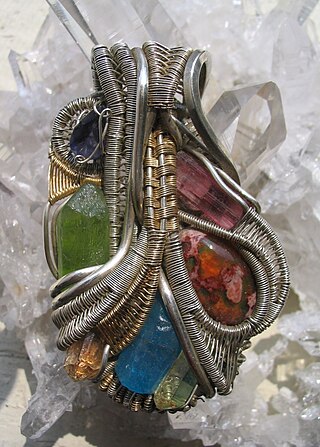
Wire wrapping is one of the oldest techniques for making handmade jewelry. This technique is done with jewelry wire and findings similar to wire to make components. Wire components are then connected to one another using mechanical techniques with no soldering or heating of the wire. Frequently, in this approach, a wire is bent into a loop or other decorative shape and then the wire is wrapped around itself to finish the wire component. This makes the loop or decorative shape permanent. The technique of wrapping wire around itself gives this craft its name of wire wrapping.

Chryssolakkos means the "pit of gold". This is where the ancient necropolis in Malia, an ancient Minoan town in Crete, Greece, is located. As well as the famous Malia Pendant, it is commonly thought that the so-called Aegina Treasure of Minoan jewellery in the British Museum was excavated here by local people in the 19th century.

Minoan art is the art produced by the Bronze Age Aegean Minoan civilization from about 3000 to 1100 BC, though the most extensive and finest survivals come from approximately 2300 to 1400 BC. It forms part of the wider grouping of Aegean art, and in later periods came for a time to have a dominant influence over Cycladic art. Since wood and textiles have decomposed, the best-preserved surviving examples of Minoan art are its pottery, palace architecture, small sculptures in various materials, jewellery, metal vessels, and intricately-carved seals.

The Thetford Hoard is a hoard of Romano-British metalwork found by Arthur and Greta Brooks at Gallows Hill, near Thetford in Norfolk, England, in November 1979, and now in the British Museum. Dating from the mid- to late-4th century AD, this hoard is a collection of thirty-three silver spoons and three silver strainers, twenty-two gold finger rings, four gold bracelets, four necklace pendants, five gold chain necklaces and two pairs of necklace-clasps, a gold amulet designed as a pendant, an unmounted engraved gem, four beads, and a gold belt-buckle decorated with a dancing satyr. A small cylindrical lidded box made from shale also belonged to the hoard.

Arts of Caucasian Albania – is the historical and regional type of arts related to Ancient East.

The Beaurains Treasure is the name of an important Roman hoard found in Beaurains, a suburb of the city of Arras, northern France in 1922. Soon after its discovery, much of the treasure was dispersed, to be sold on the antiquities market. The largest portion of the hoard can be found in the local museum in Arras and in the British Museum.

The Domagnano Treasure is an important Ostrogothic hoard found at Domagnano, Republic of San Marino in the late nineteenth century. The treasure is now divided among various institutions, including the Louvre Abu Dhabi, although the bulk of the hoard is currently held by the British Museum in London and the Germanisches Nationalmuseum in Nuremberg.

The Sutri Treasure is an important Lombardic hoard found at Sutri, Italy in the late nineteenth century that is currently in the collections of the British Museum in London.

The Artres Treasure is an important Merovingian hoard found at Artres, northern France in the nineteenth century. Most of the treasure is now in the collection of the British Museum in London.

The Bergamo Treasure is a large Lombardic and Ostrogothic hoard found near the city of Bergamo in northern Italy in the nineteenth century. It was mostly acquired by the British Museum in 1897.

The Tell el-Ajjul gold hoards are a collection of three hoards of Bronze Age gold jewellery found at the Canaanite site of Tell el-Ajjul in Gaza. Excavated by the British archaeologist Flinders Petrie in the 1930s, the collection is now mostly preserved at the British Museum in London and the Rockefeller Museum in Jerusalem. The treasure ranks amongst the greatest Bronze Age finds in the Levant.

Ancient Roman jewelry was characterized by an interest in colored gemstones and glass, in contrast with their Greek predecessors who focused primarily on the production of high-quality metalwork by practiced artisans. Extensive control of Mediterranean territories provided an abundance of natural resources to utilize in jewelry making. Participation in trade allowed access to both semi-precious and precious stones that traveled down the Persian Silk Road from the East.
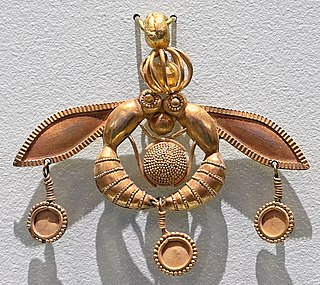
The Malia Pendant is a gold pendant found in a tomb in 1930 at Chrysolakkos, Malia, Crete. It dates to the Minoan civilization, 1800-1650 BC. The pendant was excavated by French archaeologists and was first described by Pierre Demargne. The pendant is commonly called "The Bees of Malia."
